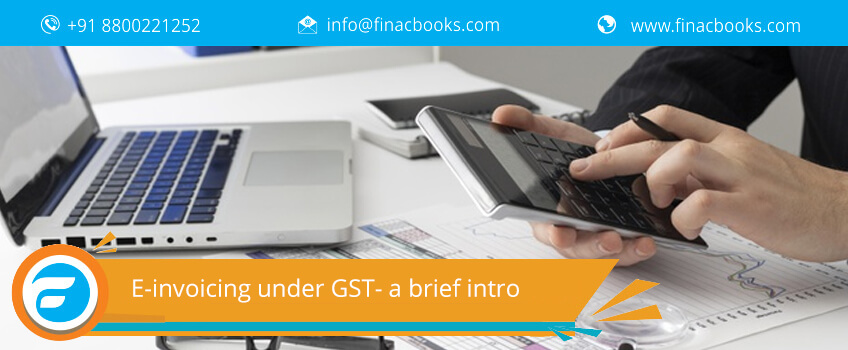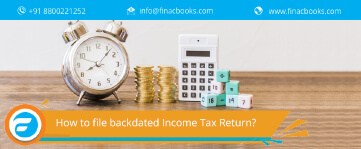What is e-invoicing under GST?
'E-Invoicing' or 'electronic invoicing' is a process through which GSTN authenticates B2B invoices electronically for further usage on the common GST portal. Under the electronic invoicing system, each invoice will be assigned an identification number by the Invoice Registration Portal (IRP), controlled by the GST Network (GSTN). The National Informatics Centre launched the first e-invoice Portal at einvoice1.gst.gov.in.
All invoice information will be sent in real-time from this portal to the GST and e-way bill portals. As a result, manual data entry will be eliminated during the filing of GSTR-1 returns and generation of part-A of e-way bills. The information will be transferred directly from the IRP to the GST portal.

Why is e-invoicing introduced?
The generation of fake invoices has always been a cause of concern for the government. To curb this crisis and prevent tax leakage, the government introduced this step in a very organized and planned manner. The government wanted to bring about a change in the overall core business process of the current scenario. This demanding scheme would now push the business world to re-assess their technology field.
Further, a question strikes the mind: Who is eligible for the e-invoicing system under GST?
The government of India has launched electronic invoicing in steps through a much-planned scheme. These steps are as described below:
- The first step, applicable since 1st October 2020 covers taxpayers who have a turnover exceeding 500 crores.
- The second step involved all the taxpayers with an aggregate turnover of more than 100 crores and was implemented on 1st January 2021.
- The third step involves the taxpayers with an aggregated turnover between 50-100 crores, which was implemented and made active on 16thMarch 2021.
- Further steps will be soon dropped down by the government.
However, there are businesses and people where this system is not implemented. This category was clearly stated in CBIC Notification No. 13/2020- Central Tax.
- A goods transport agency
- A registered person supplying passenger transportation service
- An SEZ unit
- Any Financial institution involving banks, insurers, and NBFC.
- Any registered person providing services by way of admission to the exhibition of cinematographicfilms in multiplex services.
What types of documents must be submitted to the IRP?
The e-invoicing system will cover the following documents:
The documents that will be covered under the e-invoicing system are as follows-
- Supplier invoices
- Credit notes by the supplier
- Debit notes by the recipient
- Any other document that the creator of the document is required to declare as an e-invoice under GST law
Process for e-invoice generation
The following is a step-by-step procedure for issuing an E-invoice -
- Create an invoice using existing infrastructure; however, remember that the invoice must have all mandatory information required by the e-invoice schema.
If all mandatory fields in the present infrastructure are not synchronized, the taxpayer is advised to invest in IT-enabled infrastructure.
- Authorization of e-invoices and generation of a unique IRN (Invoice Registration Number). The prepared invoice must be uploaded to the E-invoicing portal for Invoice reference number generation. For this purpose, taxpayers may access the websites that the government has approved.
- A QR code generation
What are the benefits of e-invoicing under the current business scenario?
- E-Invoice closes a significant gap in data reconciliation required by GST, hence reducing mismatch errors.
- E-Invoices generated by one software application can be read by another, facilitating interoperability and reducing data entry errors.
- E-invoice enables real-time tracking of invoices prepared by the supplier.
- Genuine input tax credits are more readily available.
- Backward integration and automation of the tax return filing process — relevant invoice details would be auto-populated in the various returns, most importantly when creating part-A of e-way bills.
- Tax authorities are less likely to conduct audits/surveys because the information they seek is available at the transaction level.
For any further assistance in GST Return filing connect with our FinacBooks team now.
No Physical GST Invoice Required When E-invoice Provided
The Central Board of Indirect Taxes and Customs (CBIC) clarified that when an e-invoice is provided, the physical invoice is not necessary to be carried. The board has taken the approach that carrying a physical copy of the invoice is required when transporting goods in circumstances where the supplier has given invoices under goods and services tax in the manner specified in rule 48(4) of the CGST Rules, 2017. (i.e. in cases of e-invoice)
How Can GST e-invoice Help Businesses Survive?
In recent years, technological advancements have resulted in significant changes to accounting management. Digital accounting has made the process of filing taxes simpler and error-free. Invoicing is also converted to digital format; accounting has been transformed especially. Invoices aid firms in monitoring their sales and maintaining financial records.
E-invoice is a technique of electronic authentication beneath the GST framework. GST officials have been authorised to issue electronic invoices through the use of the Invoice Registration Portal (IRP) for reporting B2B invoices registered with the departmental portal. This guarantees that businesses report B2B invoices on time and that they are enrolled and confirmed on the GST or GSTN portals. E-invoicing enables the dual function of monitoring B2B transactions and resolving GST compliance issues.
Major challenges of E-invoicing under GST
- If an invoice is discovered to be unregistered on the IRP, it will no longer be recognised as a valid tax invoice for any GST-related activities. A penalty of Rs.10,000 will be imposed for each occurrence of non-compliance.
- Transportation of products without a valid tax invoice may result in the detention of goods and vehicles, as well as the imposition of fines.
- Customers may refuse to accept and/or pay for products in the absence of a legitimate tax invoice, as this will impact the receiver's eligibility for ITC benefits.
- Additionally, the government intends to include a check that will stop the generation of an e-way bill in the absence of the invoice reference number.
How will electronic invoicing help combat tax evasion?
It will contribute to the reduction of tax evasion in the following ways:
- Tax authorities would have real-time access to transactions, as the e-invoice must be generated compulsorily through the GST portal.
- There will be less opportunity for invoice manipulation because the invoice is generated prior to completing a transaction.
It eliminates the possibility of fake GST invoices and allows for the claim of only legitimate input tax credits, as all invoices must be generated through the GST portal. Because input credits can be matched to output tax data, GSTN can more easily track fraudulent tax credit applications.
FAQ's
Who will be affected by e-invoicing?
The e-invoicing system will be applicable to GST registered persons with aggregate annual revenue of more than Rs.50 crore. Exceptions include units within Special Economic Zones (SEZs), insurance, financial institutions, banking, non-bank financial companies (NBFCs), the GTA, passenger transportation services, and the sale of cinema tickets.
Is bulk uploading of invoices to generate IRN's possible?
No, invoices must be entered into the IRP one at a time. A business's ERP system must be configured to accept requests for individual invoice uploads.
Is there a limit for incorporating line items in each e-invoice?
Yes, each e-invoice can contain up to a maximum of 100 items.
Is it necessary for the supplier to again sign the e-invoice digitally?
The supplier is not required to digitally sign the e-invoice that will be uploaded to IRP. After validation, the e-invoice will be automatically signed.
What are the contents of the proposed e-invoice format?
- E-invoice schemes – The section includes the name of each technical field and a description of each field. Additionally, it highlights the importance of each field, whether significant or not. Apart from that, more significant points are discussed in the section.
- Masters – Masters keep an eye on the data that is entered into pre-determined fields by the GSTN. The fields include the UQC, the invoice type, the state code and the supply type.
E-Invoice template – The e-invoicing template helps the reader in associating terms from other sheets. Mandatory terms are highlighted in green, whereas non-mandatory terms are highlighted in yellow.











